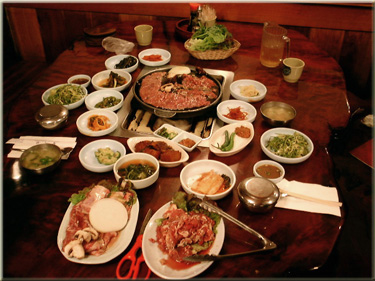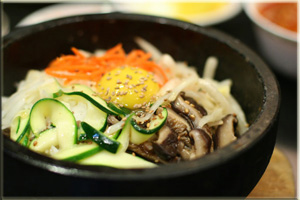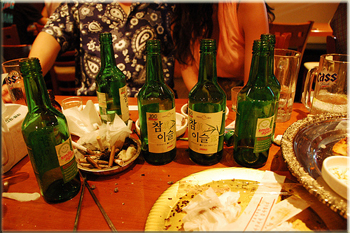South Korean Food
| Go to: | » Eating in Korea | » Drinks |

Because the land is composed mostly of mountains and extends from the North Asian landmass into warmer seas in the south, Korea has many microenvironments. Rice, beans, and vegetables are grown in the valleys while in the mountains mushrooms and many wild plants such as bracken and bellflower are either collected or cultivated. Each region has its own dishes unique to its climate. In the mountainous northeastern part of the country, for instance, the most famous dishes have plenty of wild ferns and native roots in them. In the rice-growing valleys of the south, in the region of Chonju city, the best known dish is a large bowl of rice covered in a variety of finely sliced vegetables, meats, and a spicy sauce called Bibimbap.
Koreans eat lots of seafood. Fish from the Yellow Sea differs from those of the Eastern Sea (Sea of Japan) and those of the south coast differ from the others. Koreans are seafood connoisseurs and seek out the specialties of each region. But all Koreans eat three types of seafood all the time. One kind is a small dried sardine. Bowls of these appear at every meal, including breakfast.
They’re used not as a main dish but as condiments to be eaten with others. Another is dried cuttlefish. Drive along any road or street near fishing ports and you will see lines of these cephalopods hanging out to dry. Dried cuttlefish is Korea’s most popular snack food and is even sold in vending machines. Seaweed is also a seafood, of the plant variety. There are several kinds that Koreans routinely eat. Seaweeds are nutritious and useful in a country that endures long winters. Babies are fed seaweed soups and traditional birthday celebrations include seaweed soup on the menu.
Eating in Korea
All apartments in Korea come with a kitchen so cooking your own food is normally the cheapest option. If you eat at home everyday then expect to pay about 250,000 won per month. Restaurants are fairly cheap in Korea and the food is equally good. Expect to pay 7,000 to 12,000 won per person.
European food: If you have a craving for European food there are very few options in the smaller cities though the bigger cities normally have the usual array of fast food restaurants. A Big Mac meal in McDonalds will cost about 4,500 won as will a meal in KFC. In Seoul there are many foreign food restaurants (especially in Itaewon).
Check out our article Must Try Summertime Korean Treats to learn more about what our teachers LOVE about eating in South Korea.
Drinks and South Korean Food
You will find all your normal soft drinks here as well as a few local varieties. A can will cost you 400 to 700 won in a shop, or up to 3,000 won a glass or more in an expensive bar or restaurant.
Beer ranges from 1,500 to 1800 won for a large bottle of the local Koran beer in supermarkets (depending on brand). In a restaurant or bar expect to pay from 2,000 to 3,000 won for a large bottle and in more up-market places anything from 5,000 upwards for a small bottle of local beer. Imported beers can be really expensive. In Itaewon a bottle of imported beer will cost you about 5,000 won, while some beers will cost an incredible 12,000 won!
For those nights where beer just won’t do, a bottle of Chivas Regal will set you back at least 42,000 won from a supermarket. The same bottle in a bar it will cost 70,000 to 260,000 won. A bottle of soju from a supermarket will cost you 800-1000 won for a small bottle. In a bar, it will cast you about 3,000 won.
A bottle of wine in a supermarket will cost 5,000 upwards depending on whether it is Korean on imported. Koreans don’t often drink western wines so they are really expensive here.






